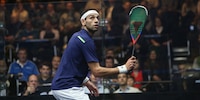
Guide
Squash racket selection: From classic hearts and teardrops
by Michael Restin

You should have the right racket in your hand for the fastest of all return games. Although there are no special rackets for beginners, advanced players and professionals, there are models with different characteristics that need to suit you and your requirements.
Basically, the rackets differ in their balance, shaft flexibility and weight, which partly depends on the material used and therefore influences the price. You can play with all of them - the only question is how well. To find the racket that suits you best, you need to know a few things.
Balanced racquets are a compromise. When you have an advantage with which balance depends on the game situation and it is not possible to say in principle which racket you can hit harder with. It depends on the swing and your technique. Shaft flexibility also plays a decisive role when it comes to power.
If you want to put more power into your shots, a flexible shaft acts like a small catapult. Unfortunately, this comes at the expense of precision. This is higher with a stiff shaft. The differences were investigated at Aalborg University.
The strokes of two advanced players were recorded and analysed with an extremely hard racquet (ultra-stiff) and an extremely flexible model (ultra-soft). While the hard racquet was almost unbent at the time of impact, the soft model deviated from its normal position by four centimetres. This makes the shot more difficult to time and control. On the other hand, it is given extra acceleration by the racket bouncing back to its original position.
You therefore need to decide which factors are particularly important for your game. You can use the table to click directly to the rackets that meet your requirements.
While the cheapest models are made of steel and aluminium, graphite and carbon are the most common materials used in racket construction. You don't have to spend a fortune on these: You can get a graphite racket made from one piece for under 100 francs.
At 88 grams, the Yonex Duora 88 is in the same weight class as most more expensive racquets, which also weigh between 80 and 90 grams, thanks to its balanced balance and stiff shaft. Even lighter does not necessarily mean better - the accelerated mass can ultimately also contribute to the hardness of the shot.
Simple writer and dad of two who likes to be on the move, wading through everyday family life. Juggling several balls, I'll occasionally drop one. It could be a ball, or a remark. Or both.
Practical solutions for everyday problems with technology, household hacks and much more.
Show allThe weight distribution of the racket creates advantages and disadvantages in different playing situations. This is why it is an important point when making a selection . Head-heavy rackets are ideal for offensive players and are always at their best when you can execute long strokes. With the centre of gravity shifted towards the racket head, you can accelerate optimally when smashing and apply a lot of power to the shuttle. This is also an advantage when playing the baseline.
Handle-heavy racquets have their strengths in fast wrist movements. If you are on defence and have to react reflexively, you are better served with this racket in this situation. Doubles specialists also often play grip-heavy racquets because they have little reaction time. Conversely, they offer you less power on smashes and baseline shots.
| **Balance/
Shank flexibility** | Power offensive | Power defensive | balanced |
|---|---|---|---|
| Designed for power | [kopflastig / flexibel](https://www.galaxus.ch/de...) | [grifflastig / flexibel](https://www.galaxus.ch/de...) | [ausgewogen / flexibel](https://www.galaxus.ch/de...) |
| balanced | [kopflastig / ausgewogen](https://www.galaxus.ch/de...) | [grifflastig / ausgewogen](https://www.galaxus.ch/de...) | [ausgewogen / ausgewogen](https://www.galaxus.ch/de...) |
| Designed for precision | [kopflastig / steif](https://www.galaxus.ch/de...) | [grifflastig / steif](https://www.galaxus.ch/de...) | [ausgewogen / steif](https://www.galaxus.ch/de...) |
What makes more expensive models different?More nano and high technology is always possible, it's just not so easy to explain. When weight is no longer a criterion, special materials come into play to further optimise the properties of the rackets to meet specific requirements. This doesn't hurt the beginner - they also benefit from such a racquet - and can be fully utilised by the pros. For example, the Yonex Nanoray Z-Speed with 83 grams and its aerodynamic construction is so optimised for fast swing behaviour and high power that the smash world record of 493 km/h was set with it. Among other things, the racket features a "Snap Back Zone", in which EX-HMG, the most elastic material in racket construction, provides additional acceleration.Before you get lost in the details, you are well advised to first decide on the desired balance and shaft flexibility according to the table above, before the finer details of the material and ultimately your budget tip the scales. You don't need to buy an additional cover: With us, you'll mainly find rackets from the Yonex brand, all of which come with a cover and a stringing hardness of around 9 kg. <p